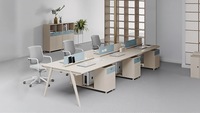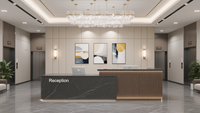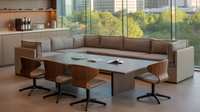In a modern office—whether it's a bustling workplace or a home studio—a well-planned lounge area is no longer a luxury but a necessity. It offers employees, clients, or yourself a space to recharge, think freely, and even engage in informal collaboration. If you're looking to design or improve your work area lounge, this guide walks you through the essentials of turning any corner into a functional, comfortable retreat.

1. Define the Purpose of Your Lounge Area
Before diving into design decisions, take time to clarify the main role of this space. Purpose drives layout, furniture selection, and atmosphere.
What will the lounge area be used for?
Is this a quiet zone for relaxing breaks? A creative corner for brainstorming? A semi-casual space for client meetings? Understanding the “why” behind the lounge helps you prioritize what elements it should include—whether that’s plush armchairs for unwinding, or tables and power outlets for collaborative sessions.
How frequently will it be used, and by whom?
A space used daily by multiple team members needs to be more durable and versatile than a personal reading nook used occasionally. If you're designing a shared workspace, you may also need to consider inclusivity, flexibility, and ease of access.A clearly defined purpose not only streamlines design choices but ensures the space genuinely supports how you work.

2. Choose Functional, Comfortable Furniture
Furniture selection can make or break a lounge area. The goal is to strike the right balance between aesthetic appeal, comfort, and usability.
Sofas and lounge chairs:
Look for pieces that invite people to sit and stay awhile. Upholstered, low-profile seating is ideal for creating a sense of coziness. But make sure comfort doesn’t compromise posture support—especially if people will be using laptops or holding discussions while seated.
Coffee tables or side tables:
These provide practical surfaces for drinks, notebooks, or decorative items. Opt for tables with additional storage (like lower shelves or drawers) if you want to keep magazines, chargers, or extra supplies organized and out of sight.
Ottomans or modular seating:
Great for small or multi-use spaces, modular furniture can be reconfigured easily to accommodate different activities. Ottomans can double as footrests, seats, or even makeshift tables with the right tray.
Storage solutions:
Clutter kills the calm vibe of a lounge. Use magazine racks, closed cabinets, or even built-in wall units to keep items organized. Clean lines and minimalist storage help maintain a sense of calm and order.
Don't forget: the materials you choose should be both durable and easy to clean—especially in high-traffic areas.

3. Plan a Practical, Welcoming Layout
Even with beautiful furniture, a poorly arranged lounge can feel awkward or underutilized. Good layout design ensures the space flows naturally and encourages people to use it.
Create natural pathways:
Avoid blocking windows, doors, or walkways. Leave enough space between furniture pieces so people can move around easily without bumping into things. A clutter-free layout enhances accessibility and makes the area feel more open and breathable.
Use subtle zoning techniques:
Rugs are excellent tools for visually defining the lounge space, especially in open-plan offices. Pair with lighting or different floor levels to gently distinguish the lounge from surrounding workstations, without cutting it off entirely.
Balance privacy and connection:
Position chairs and sofas to promote conversation, but consider spacing and orientation to provide some privacy too. For example, arrange seating to face inward for small group interactions, while still leaving some solo spots near windows or quiet corners.
Remember, the layout should support both the physical and psychological comfort of its users.

4. Enhance the Atmosphere with Finishing Touches
What transforms a lounge from "just a few chairs" into a space people love is the mood you create through thoughtful styling.
Layered lighting:
Skip harsh overhead lights. Instead, combine ambient lighting (like wall sconces or floor lamps) with task lighting (such as table lamps). A warm light temperature (2700K–3000K) promotes relaxation, while cooler light can keep things alert and focused if the space is more collaborative.
Textiles and textures:
Cushions, throws, and fabric upholstery bring softness and warmth. They also provide a great opportunity to introduce subtle color or pattern into the design without overwhelming the senses.
Greenery:
Add indoor plants to boost air quality and make the space feel lively. Even a few well-placed planters or hanging vines can refresh the area. Low-maintenance options like pothos, peace lilies, or succulents work well for office settings.
Personal touches and decor:
Consider framed prints, art pieces, books, or a statement rug. These add character to the space and signal that it’s meant for more than just sitting—it's a place to pause and enjoy.
The goal here is to make the space feel “finished” and intentional, without cluttering or over-decorating.

5. Keep It Clean, Clear, and Ready to Use
Even the best-designed lounge will fall flat if it becomes a dumping ground for mess. Ongoing maintenance is key to keeping it attractive and useful.
Establish a simple cleaning routine:
Set a weekly schedule to declutter, wipe surfaces, fluff cushions, and water plants. In shared environments, assign rotating responsibilities or have your cleaning team give it regular attention.
Encourage shared responsibility:
In workplaces, signs like “Please tidy up after use” or “Keep this space beautiful” can be gentle but effective reminders. Provide a small bin or recycling spot nearby so trash doesn’t accumulate.
Ensure accessibility and inclusivity:
Avoid overly tight furniture placement and consider ergonomic variety—such as low seats, armrests, and options for people who need more support. A well-thought-out lounge should be inviting to everyone.
When a space is clean, organized, and welcoming, it becomes a natural part of the daily workflow—not just an afterthought.

Final Thoughts
Organizing your work area lounge space isn’t just a design challenge—it’s a chance to support better habits, smoother collaboration, and healthier routines. Done right, a lounge becomes more than just furniture in a corner: it becomes a quiet hub of comfort, creativity, and connection.
Whether you’re redesigning a corporate office or making the most of a small home studio, thoughtful planning and a few key elements can turn even the simplest corner into one of the most valued spaces in your work environment.





